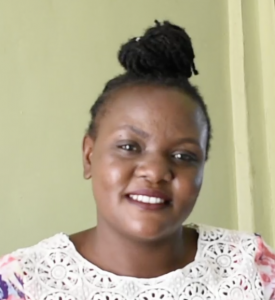There is a gradual slope as you walk towards Kaikai Spring, located in Emuyere village. The land becomes steep as you get nearer the water source, with green vegetation and farm plots surrounding it. The most common livelihood in this community is farming. Community members have embraced both crop farming and livestock farming. They rear poultry, cattle, and pigs and grow maize, beans, vegetables, and sweet potatoes.
The Emuyere community members have embraced their culture a lot. They have traditional bullfighting that takes place every Saturday morning at the Makunga Market. People from Emuyere and the neighboring communities gather and watch the fighting together. The surrounding communities have bonded because of this routine bullfighting. Additionally, Emuyere hosts a boys' football club that meets for practice Saturday and Sunday afternoons.
315 people in the Emuyere area depend on Kaikai Spring for water. Their entire day revolves around fetching enough water from this unprotected spring for most women and children.
Selpher Muchenya, a mother and farmer in the community, is no exception to this. Every day Selpher wakes up at 5:00 am. She does some house chores like washing the utensils, cleaning the house, and then preparing breakfast. Selpher does this using the water she fetched the previous day.
After Selpher is done with the morning chores, she goes for four roundtrips to get water before going to the farm. She likes fetching water in the morning hours while the water is still and undisturbed. She says that the water she fetches this early is mainly used for drinking and cooking. At 9:00 am, Selpher goes to the farm until noon. When she comes back, she prepares lunch for the family. After they have had their lunch, she washes the dishes, then showers and rests for a while.
At 4:00 pm, Selpher starts her trips to fetch more water. She goes for another four roundtrips, then starts preparing dinner for the family. They always have their dinner at 7:00 pm. Between 8-9:00 pm, they are done with eating. They chat with family members about how the day was and plan for the next day. At 9:00 pm, it is time for all of them to go to bed.
All these trips for water, yet it is contaminated and puts Selpher and her family's health, along with the rest of the community, at risk. The spring is completely open to the environment and, thus, contamination from animal and human activity alike. Drinking contaminated water leads to waterborne diseases. The community reports frequent typhoid cases, dysentery, and stomach issues after drinking water from the unprotected spring. These illnesses are expensive to treat, draining families of their financial resources in addition to their energy and time for productive activities.
"The water from this water source is not clean, so we have to treat it with Aquatabs or chlorine. Sometimes, we do not have money to buy the Aquatabs and chlorine, so we take the water as it is. Drinking this water without treatment has caused us and our children to suffer from typhoid and diarrhea," said Selpher, who also serves as her community's Village Health Volunteer.
As Selpher noted, water fetched early in the morning is best while it is still clean. To fetch water, community members have to scoop the water with jugs and small bowls to pour into their larger jerrycans. This adds bacteria and stirs up dirt into the water. The slippery drawing point made up of a few stones placed in the water also leads to falls, injuring community members and further contaminating the water. Shoes and toes commonly dip into the water by accident while people fetch it.
This scoop-pour method is tiring and time-consuming, and it slows people down as they fetch. Crowds and long waits are commonplace at the spring, wasting community members' previous time.
"We are supposed to fetch water early in the morning while the water is still clean. Before going to school, I have to fetch water. This consumes a lot of my time in preparation for school," said Joseph, a young teenager in the community.
What We Can Do:
Spring Protection
Protecting the spring will help provide access to cleaner and safer water and reduce the time people have to spend to fetch it. Construction will keep surface runoff and other contaminants out of the water. With the community’s high involvement in the process, there should be a good sense of responsibility and ownership for the new clean water source.
Fetching water is a task predominantly carried out by women and young girls. Therefore, protecting the spring and offering training and support will help empower the community's female members by freeing up more of their time and energy to engage and invest in income-generating activities and their education.
Training on Health, Hygiene, COVID-19, and More
To hold training during the pandemic, we work closely with both community leaders and the local government to approve small groups to attend training. We ask community leaders to invite a select yet representative group of people to attend training who will then act as ambassadors to the rest of the community to share what they learn. We also communicate our expectations of physical distancing and wearing masks for all who choose to attend.
The training will focus on improved hygiene, health, and sanitation habits in this community. We will also have a dedicated session on COVID-19 symptoms, transmission routes, and prevention best practices.
With the community’s input, we will identify key leverage points to alter their practices at the personal, household, and community levels to affect change. This training will help ensure participants have the knowledge they need about healthy practices and their importance to make the most of their water points as soon as the water is flowing.
Our team of facilitators will use a variety of methods to train community members. Some of these methods include participatory hygiene and sanitation transformation, asset-based community development, group discussions, handouts, and demonstrations at the spring.
One of the most important issues we plan to cover is handling, storing, and treating water. Having a clean water source will be extremely helpful, but it is useless if water gets contaminated by the time it is consumed. The community and we strongly believe that all of these components will work together to improve living standards here, which will help to unlock the potential for these community members to live better, healthier lives.
We will then conduct a small series of follow-up training before transitioning to our regularly scheduled support visits throughout the year.
Training will result in forming a water user committee, elected by their peers, that will oversee the spring's operations and maintenance. The committee will enforce proper behavior around the spring and delegate tasks that will help preserve the site, such as building a fence and digging proper drainage channels. The fence will keep out destructive animals and unwanted waste, and the drainage will keep the area’s mosquito population at a minimum.

 Protected Spring
Protected Spring
 Rehabilitation Project
Rehabilitation Project


































